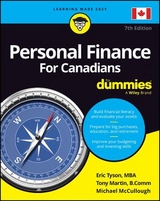
Personal Finance For Canadians For Dummies
For Dummies (Verlag)
978-1-119-52279-9 (ISBN)
- Titel erscheint in neuer Auflage
- Artikel merken
Personal Finance For Canadians For Dummies offers readers a comprehensive roadmap to financial security. Written by expert authors Eric Tyson and Tony Martin, it offers pointers on how you can eliminate debt and rein in spending, along with helpful tips on how to reduce taxes and save more.
The guide also offers a primer on investing, showing how you can build your wealth to ensure a comfortable retirement and university or college for the kids. With up-to-date Canadian examples and references, Personal Finance For Canadians For Dummies arms you with the tools you need to take control of your financial life—in good times and bad.
Make smart personal finance decisions
Plan the personal finance portfolio that's right for you
Reach your personal finance goals
Know all of your options
The expert advice offered in Personal Finance For Canadians For Dummies is for anyone looking to ensure that their finances are on the right track—and to identify the best strategies to improve their financial health.
Eric Tyson, MBA, is a renowned finance counselor, syndicated columnist, and author of numerous bestselling financial titles. Tony Martin, B.Comm, is a nationally-recognized personal finance, speaker, commentator, columnist, management trainer, and communications consultant. He is the co-author of Personal Finance For Canadians For Dummies.
Introduction 1
About This Book 2
Foolish Assumptions 3
Icons Used in This Book 3
Beyond the Book 4
Where to Go from Here 4
Part 1: Getting Started with Personal Finance 5
Chapter 1: Improving Your Financial Literacy 7
Talking Money at Home 8
Identifying Unreliable Sources of Information 10
Understanding the dangers of free financial content online 10
Recognizing fake financial gurus 11
Publishers pandering to advertisers 14
Jumping over Real and Imaginary Hurdles to Financial Success 15
Discovering what (or who) is holding you back 16
Developing good financial habits 16
Chapter 2: Measuring Your Financial Health 19
Avoiding Common Money Mistakes 20
Determining Your Financial Net Worth 22
Adding up your financial assets 22
Subtracting your financial liabilities 23
Crunching your numbers 24
Interpreting your net worth 24
Examining Your Credit Score and Reports 25
Understanding what your credit data includes and means 25
Obtaining your credit reports and score 26
Improving your credit reports and score 28
Getting credit report errors corrected 29
Knowing the Difference between Bad Debt and Good Debt 30
Consuming your way to bad debt 31
Recognizing bad debt overload 32
Assessing good debt: Can you get too much? 33
Playing the credit-card float 34
Analyzing Your Savings 35
Evaluating Your Investment Knowledge 36
Assessing Your Insurance Savvy 38
Chapter 3: Managing Where Your Money Goes 39
Examining Overspending 40
Having access to credit 40
Misusing credit cards 40
Taking out car loans 41
Bending to outside influences and agendas 42
Spending to feel good 43
Analyzing Your Spending 43
Tracking spending the low-tech way 44
Tracking your spending on “free” websites and apps 49
Chapter 4: Establishing and Achieving Goals 53
Creating Your Own Definition of Wealth 53
Acknowledging what money can’t buy 54
Managing the balancing act 54
Prioritizing Your Savings Goals 56
Knowing what’s most important to you 57
Valuing retirement plans 57
Dealing with competing goals 58
Building Emergency Reserves 58
Saving to Buy a Home or Business 59
Funding Kids’ Educational Expenses 60
Saving for Big Purchases 60
Preparing for Retirement 61
Figuring out what you need for retirement 62
Understanding retirement building blocks 64
Crunching numbers for your retirement 77
Making up for lost time 79
Part 2: Spending Less, Saving More 81
Chapter 5: Dealing with Debt 83
Using Savings to Reduce Your Consumer Debt 84
Understanding how you gain 84
Finding the funds to pay down consumer debts 85
Decreasing Debt When You Lack Savings 86
Reducing your credit card’s interest rate 86
Understanding all credit-card terms and conditions 87
Cutting up your credit cards 87
Discovering debit cards: The best of both worlds 88
Turning to Credit-Counselling Agencies 89
Beware biased advice at credit-counselling agencies 90
Ask questions and avoid debt-management programs 91
Filing Bankruptcy 92
Understanding bankruptcy benefits 93
Coming to terms with bankruptcy drawbacks 95
Seeking bankruptcy advice 96
Considering a Consumer Proposal:
An Alternative to Bankruptcy 97
Stopping the Spending/Consumer Debt Cycle 98
Resisting the credit temptation 98
Identifying and treating a compulsion 99
Chapter 6: Reducing Your Spending 101
Unlocking the Keys to Successful Spending 101
Living within your means 102
Looking for the best values 103
Cutting excess spending 108
Shunning consumer credit 109
Budgeting to Boost Your Savings 109
Reducing Your Spending 110
Managing food costs 111
Saving on shelter 115
Cutting transportation costs 117
Lowering your energy costs 120
Controlling clothing costs 121
Repaying your debt 122
Indulging responsibly in fun and recreation 122
Lowering your phone bills 124
Technology: Spending wisely 126
Curtailing personal-care costs 126
Paring down professional expenses 127
Managing medical expenses 128
Eliminating costly addictions 129
Keeping an eye on insurance premiums 130
Trimming your taxes 131
Chapter 7: Trimming Your Taxes 133
Understanding the Taxes You Pay 133
Focusing on your total taxes 134
Recognizing the importance of your marginal tax rate 134
Defining taxable income 136
Being mindful of the second tax system: Alternative minimum tax 136
Trimming Employment Income Taxes 137
Contributing to registered retirement plans 137
Shifting some income 138
Increasing Your Deductions 139
Childcare expenses 139
Alimony and maintenance payments 140
Child support 140
Annual union and professional fees 140
Business losses 141
Interest on investment loans 141
Moving expenses 141
Making the Most of Tax Credits 142
Understanding how the federal and provincial tax systems work together 142
Maximizing your tax credits 143
Trading consumer debt for mortgage debt 147
Deducting self-employment expenses 148
Reducing Investment Income Taxes 150
Selecting other tax-friendly investments 150
Making your profits long term 150
Enlisting Education Tax Breaks 151
Getting Help from Tax Resources 153
Obtaining CRA assistance 153
Consulting preparation and advice guides 154
Using software and websites 154
Hiring professional help 154
Dealing with an Audit 156
Getting your act together 156
Surviving the day of reckoning 157
Part 3: Building Wealth through Investing 159
Chapter 8: Considering Important Investment Concepts 161
Establishing Your Goals 161
Understanding the Primary Investments 162
Looking at lending investments 162
Exploring ownership investments 163
Shunning Gambling Instruments and Behaviors 164
Forsaking futures, options, and other derivatives 165
Ditching day trading 165
Understanding Investment Returns 166
Sizing Investment Risks 167
Comparing the risks of stocks and bonds 167
Focusing on the risks you can control 168
Discovering low-risk, high-return investments 169
Diversifying Your Investments 170
Spreading the wealth: Asset allocation 171
Allocating money for the long term 173
Sticking with your allocations: Don’t trade 174
Investing lump sums via dollar-cost averaging 175
Acknowledging Differences among Investment Firms 176
Focusing on the best firms 177
Places to consider avoiding 179
Seeing through Experts Who Predict the Future 183
Investment newsletters 184
Investment gurus 184
Leaving You with Some Final Advice 186
Chapter 9: Understanding Your Investment Choices 189
Slow and Steady Investments 189
Transaction/chequing accounts 190
Savings accounts and money-market funds 190
Bonds 191
Building Wealth with Ownership Vehicles 193
Socking your money away in stocks 193
Investing internationally in stocks 194
Generating wealth with real estate 201
Investing in small business (and your career) 205
Off the Beaten Path: Investment Odds and Ends 208
Precious metals 209
Bitcoin and other cryptocurrencies 209
Annuities 211
Collectibles 211
Chapter 10: Investing in Funds 213
Understanding the Benefits of Mutual Funds and Exchange-Traded Funds 214
Exploring Various Fund Types 215
Money-market funds 215
Bond funds 216
Stock funds 217
Balancing bonds and stocks: Hybrid funds 218
Canadian, U.S., international, and global funds 218
Index funds 219
Specialty (sector) funds 220
Selecting the Best Funds 221
Reading prospectuses and annual reports 222
Keeping costs low 222
Evaluating historic performance 225
Assessing fund-manager and fund-family reputations 225
Rating tax-friendliness 226
Determining your needs and goals 226
Deciphering Your Fund’s Performance 227
Interest and dividends 228
Capital gains 228
Share-price changes 229
Evaluating and Selling Your Funds 229
Chapter 11: Taking Advantage of Registered Retirement Savings Plans 231
Understanding How RRSPs Work 232
The benefits of tax-deductible contributions 232
The payoff from tax-deferred compound growth 233
Maximizing Your RRSP’s Growth 234
The payoff from starting an RRSP early 234
Increasing your returns 235
Examining the Contribution Rules 237
Checking out the contribution limits 237
How much can you contribute? 238
Types of Registered Retirement Savings Plans 241
Taking Money Out of Your Plan before Retirement 243
Regular withdrawals before retirement 244
Special circumstances 244
Closing Down Your RRSP 245
Registered Retirement Income Funds 246
Annuities 249
Chapter 12: Investing in Retirement Plans 253
Allocating Your Money in Retirement Plans 254
Understanding the difference between a retirement plan and the investments inside a retirement plan 254
Prioritizing retirement contributions 255
Allocating money when your employer selects the investment options 256
Allocating money in retirement plans you design 259
Understanding annuities: An odd investment 266
Transferring Retirement Plans 267
Transferring retirement plans you control 267
Moving money from an employer’s plan 269
Chapter 13: Investing Outside Tax-Sheltered Retirement Plans 271
Getting Started 272
Paying off high-interest debt 272
Taking advantage of tax breaks 273
Taking Advantage of Tax-Free Savings Accounts 273
Understanding how much you can contribute 274
Understanding your investment choices 275
Making withdrawals 275
Understanding Registered Disability Savings Plans 276
Determining whether you’re eligible for an RDSP 276
Earning disability grants 277
Withdrawing funds 277
Understanding Taxes on Your Investments 278
Fortifying Your Emergency Reserves 279
Bank and credit-union accounts 279
High-interest savings accounts 280
Money-market funds 281
Investing for the Longer Term (Several Years or Decades) 284
Defining your time horizons 285
Bonds and bond funds 285
Guaranteed investment certificates 287
Stocks and stock funds 287
Annuities 288
Real estate 288
Small-business investments 288
Chapter 14: Investing for Educational Expenses 289
Strategizing to Pay for Educational Expenses 290
Estimating university or college costs 290
Setting realistic savings goals 291
Strategies for Saving for Education Expenses 292
Registered Education Savings Plans 292
In-trust accounts 296
Obtaining Loans, Grants, and Scholarships 297
Government student-loans programs 298
Canada Student Grants 300
Tips for getting loans, grants, and scholarships 304
Investing Educational Funds 305
Good investments: No-load mutual funds and exchange-traded funds 305
Bad investments 306
Overlooked investments 306
Chapter 15: Investing in Real Estate: Your Home and Beyond 309
Deciding Whether to Buy or Rent 310
Assessing your timeline 310
Determining what you can afford 310
Calculating how much you can borrow 311
Comparing owning versus renting costs 313
Considering the long-term costs of renting 316
Recognizing advantages to renting 318
Financing Your Home 318
Understanding mortgage essentials 319
Examining the difference between fixed- and variable-rate mortgages 323
Checking out the Home Buyers’ Plan 324
Avoiding the down-payment blues 327
Finding the best lender 329
Increasing your approval chances 331
Finding the Right Property 332
Condo, town house, co-op, or detached home? 332
Casting a broad net 333
Finding out actual sale prices 333
Researching the area 334
Working with Real-Estate Agents 335
Recognizing conflicts of interest 335
Looking for the right qualities in real-estate agents 336
Putting Your Deal Together 338
Negotiating 101 338
Inspecting before you buy 338
Remembering title insurance 339
After You Buy 340
Refinancing your mortgage 340
Considering mortgage life insurance 342
Weighing the pros and cons of a reverse mortgage 343
Selling your house 344
Part 4: Insurance: Protecting What You Have 347
Chapter 16: Insurance: Getting What You Need at the Best Price 349
Discovering the Three Laws of Buying Insurance 350
Insure for the big stuff; don’t sweat the small stuff 350
Buy broad coverage 355
Shop around and buy direct 357
Dealing with Insurance Problems 360
Knowing what to do if you’re denied coverage 360
Getting your due on claims 361
Chapter 17: Insurance on You: Life, Disability, Long Term Care, and Medical 367
Providing for Your Loved Ones: Life Insurance 368
Determining how much life insurance to buy 368
Looking at the Canada Pension Plan and Quebec
Pension Plan’s survivor benefits 369
The impact on Old Age Security benefits 370
Comparing term life insurance to cash-value life insurance 371
Making your decision 374
Buying term insurance 375
Considering the purchase of cash-value life insurance 377
Getting rid of cash-value life insurance 377
Preparing for the Unpredictable: Disability Insurance 378
Deciding whether you need coverage 378
Determining how much disability insurance you need 379
Identifying other features you need in disability insurance 380
Deciding where to buy disability insurance 381
Planning for Nursing-Home Care: Long-Term-Care Insurance 382
Getting Care for the Road: Travel Medical Insurance 383
Determining what coverage you already have 383
Buying travel medical insurance 384
Chapter 18: Covering Your Assets 385
Insuring Your Home 385
Dwelling coverage: The cost to rebuild 386
Personal property coverage: For your things 386
Liability insurance: Coverage for when others are harmed 387
Flood and earthquake insurance: Protection from Mother Nature 388
Deductibles: Your cost with a claim 390
Special discounts 390
Buying homeowner’s or renter’s insurance 390
Auto Insurance 101 391
Bodily-injury and property-damage liability insurance 391
Uninsured or underinsured motorist liability 392
Deductibles 392
Special discounts: Auto edition 393
Little-stuff coverage to skip 393
Buying auto insurance 394
Protecting against Mega-Liability: Umbrella Insurance 395
Planning Your Estate 395
Wills, living wills, and medical powers of attorney 396
Avoiding probate through living trusts 397
Planning your estate to minimize taxes triggered by your death 398
Part 5: Where to Go for More Help 401
Chapter 19: Working with Financial Planners 403
Surveying Your Financial Management Options 403
Doing nothing 404
Doing it yourself 404
Hiring financial help 404
Deciding Whether to Hire a Financial Planner 407
How a good financial planner can help 408
Understanding why planners aren’t for everyone 409
Recognizing conflicts of interest 409
Finding a Good Financial Planner 413
Soliciting personal referrals 413
Seeking planners through associations 414
Interviewing Financial Planners: Asking the Right Questions 414
Learning from Others’ Mistakes 418
Chapter 20: Using Technology to Manage Your Money 419
Surveying Software, Apps, and Websites 419
Adding up financial software benefits 420
Understanding how apps can benefit and harm your bottom line 421
Surfing hazards online 422
Accomplishing Money Tasks on Your Computer, Tablet, or Smartphone 425
Paying your bills and tracking your money 425
Planning for retirement 427
Preparing your taxes 428
Researching investments 428
Trading online 429
Reading and searching periodicals 430
Investing through automated investment managers: Robo advisors 430
Buying life insurance 431
Preparing legal documents 431
Chapter 21: Online, On Air, and in Print 433
Observing the Mass Media 433
Alarming or informing? 434
Teaching questionable values 434
Worshipping prognosticating pundits 435
Rating Radio and TV Financial Programs 435
Finding the Best Websites 436
Navigating Newspapers and Magazines 436
Betting on Books 437
Part 6: The Part of Tens 439
Chapter 22: Survival Guide for Ten Life Changes 441
Starting Out: Your First Job 442
Changing Jobs or Careers 443
Getting Married 444
Buying a Home 446
Having Children 446
Starting a Small Business 449
Caring for Aging Parents 450
Divorcing 452
Receiving a Windfall 453
Retiring 455
Chapter 23: Ten Tactics to Thwart Identity Theft and Fraud 457
Save Phone Discussions for Friends Only 458
Never Respond to Emails Soliciting Information 459
Review Your Monthly Financial Statements 459
Secure All Receipts 460
Close Unnecessary Credit Accounts 460
Regularly Review Your Credit Reports 460
Keep Personal Info Off Your Cheques 461
Protect Your Computer and Files 461
Protect Your Mail 462
Clean Out Your Wallet 462
Glossary 463
Index 477
| Erscheinungsdatum | 24.11.2018 |
|---|---|
| Sprache | englisch |
| Maße | 185 x 234 mm |
| Gewicht | 726 g |
| Themenwelt | Wirtschaft ► Betriebswirtschaft / Management ► Finanzierung |
| Wirtschaft ► Betriebswirtschaft / Management ► Rechnungswesen / Bilanzen | |
| ISBN-10 | 1-119-52279-X / 111952279X |
| ISBN-13 | 978-1-119-52279-9 / 9781119522799 |
| Zustand | Neuware |
| Informationen gemäß Produktsicherheitsverordnung (GPSR) | |
| Haben Sie eine Frage zum Produkt? |
aus dem Bereich



